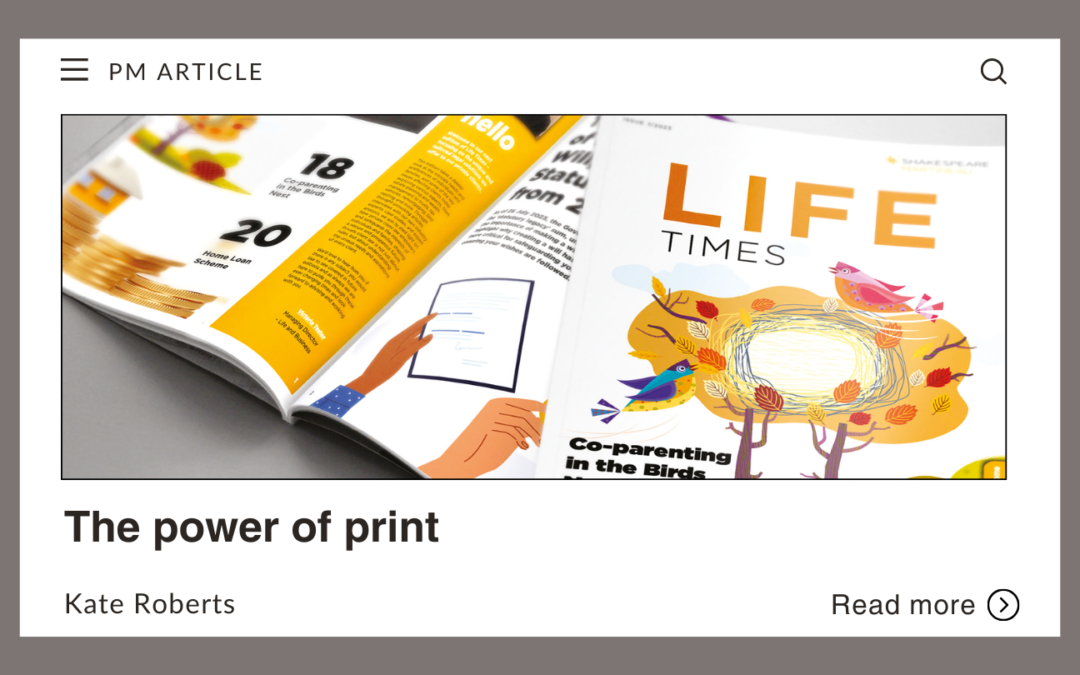In a noisy world, print is enjoying a renaissance. Kate Roberts at Shakespeare Martineau explains why.
Using a mix of media and different channels to distribute tailored information is essential to professional services marketing. But as with everything, audience is key and certain audiences digest and respond to content in different ways – which is where print comes into its own.
Is mixed media still relevant?
Legal matters often span across various demographics – with private individuals (even if they are corporate clients) constituting a significant portion of clients seeking or needing legal services – for example, wills and estate planning, succession planning, tax planning, residential conveyancing and family law. Using a mix of media channels allows law firms to reach diverse audiences and cater to their unique preferences and information consumption habits.
As we know, different platforms offer distinct opportunities for delivering tailored information and engaging with audiences. Digital platforms provide the immediacy and interactivity that we want and need for certain services. At the other end of the scale, print magazines can offer a tangible and immersive reading experience that can arguably offer a deeper connection and better engagement, particularly among certain demographics.
Building a relationship with a client, be it a transactional one (for example a corporate deal), a private client, or a distress purchase like litigation, an environment of trust and authority is invaluable – and often print media conveys this sense of authority and credibility that can be so important. Being featured in reputable publications enhances a law firm’s reputation and instils trust in potential clients, especially among certain audiences who may place greater emphasis on traditional forms of communication.
So why not print your own? We do – and here’s why.
There are distinct advantages to using print materials to communicate to a less tech-savvy audience.
Accessibility and familiarity
A print magazine provides a familiar format that resonates with individuals who may not be as digitally savvy as others. Holding a physical magazine evokes a sense of nostalgia and comfort, making it easier for some readers to engage with the content at their own pace, without the noise of consuming content on a digital platform that aims to pull their attention elsewhere.
Targeted content and relevance
Print magazines offer the opportunity to deliver tailored content that addresses the specific needs and concerns of distinct audiences. Whether it’s articles on family and children law, estate planning, retirement, elderly law, residential conveyancing or tax, print publications can curate content that speaks directly to the interests of those individuals, ensuring relevance and resonance.
A sensory experience
There’s nothing quite like holding something ‘real’. Reading a print magazine engages several senses, creating an experience that digital platforms just cannot replicate. From the texture of the paper to the smell of the ink, print magazines evoke a tactile and emotional connection that can enhance the overall reading experience. I can’t be the only one who has sniffed a new book, can I?
It stands out
In a world of constant screen exposure, a print magazine can be a most welcome change. They stand out.
A back catalogue
A magazine can possess longevity – often kept, remembered, highlighted and referenced when that service or information is needed.
Brand awareness
Physical print materials can make a lasting impact on readers’ memory as individuals tend to remember information presented in a tangible format that isn’t drowned out by other competitors online.
A perceived higher quality
Certain audiences associate information and articles in print media to be of a higher quality compared to digital alternatives. You’ll see many premium brands using print materials – you could be one too.
Easier to read
Long-form content is far more reader-friendly in print format.
With all the above in mind, we are now in the third year of printing our private client magazine Life Times– aimed very much at legal services and useful information for the private individual.
It enables us to target and create a feeling of quality, achieve longevity, include long-form articles, showcase our expertise, use engaging graphics and photography, and create brand awareness by using creative elements that link back to our website to an audience who often prefer and actively choose to engage with content in this way.
We’ve worked hard to ensure the look and feel is right too, experimenting with paper styles and weights to ensure we make the most of that sensory experience.
And yes, we get leads from it too!
ESG credentials?
While print materials offer undeniable advantages, it’s important to address the sustainability concerns associated with their production and distribution – but there are ways to mitigate their environmental impact.
A hybrid approach incorporating digital alternatives, such as online magazines or digital editions alongside print publications, allows firms to reach wider audiences while minimising paper consumption and waste. This is what we do.
Encouraging readers to recycle or responsibly dispose of print magazines after use can help minimise waste.
Shakespeare Martineau is a B-Corp. If you’re not familiar with B-Corp accreditation, it is about business transforming the global economy to benefit all people, communities and the planet. There are currently over 8,000 businesses worldwide that are accredited, and the number is growing all the time. As a firm, we have worked hard to meet the highest standards of social and environmental performance, transparency and accountability, and since 2019 we have reduced our paper usage by over 70%.
We use print companies that prioritise sustainable practices, such as using recycled paper and eco-friendly inks which help reduce the environmental footprint of print media production. In addition, we ensure we minimise waste through efficient production methods (not bulk printing because it’s cheaper) and prioritising renewable energy sources throughout the printing process.
Using a mix of media for effective communication is essential for firms looking to reach and engage with diverse audiences. Digital platforms undeniably offer immediacy and interactivity, but print remains a powerful tool for connecting with different demographics and building credibility and trust in the legal industry – in our case.
By addressing sustainability concerns and adopting responsible printing practices, we can ensure we reach the right people, in the right way… while sitting comfortably.
Kate Roberts is a Marketing Content Manager at Shakespeare Martineau.
Members only: if you want to add this reading to your CPD, please log in and complete the evaluation
Log in



